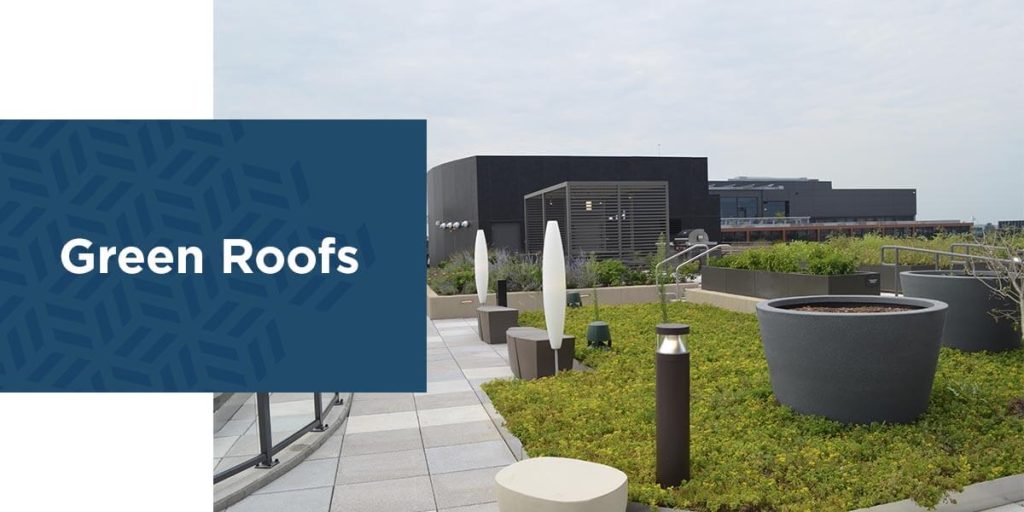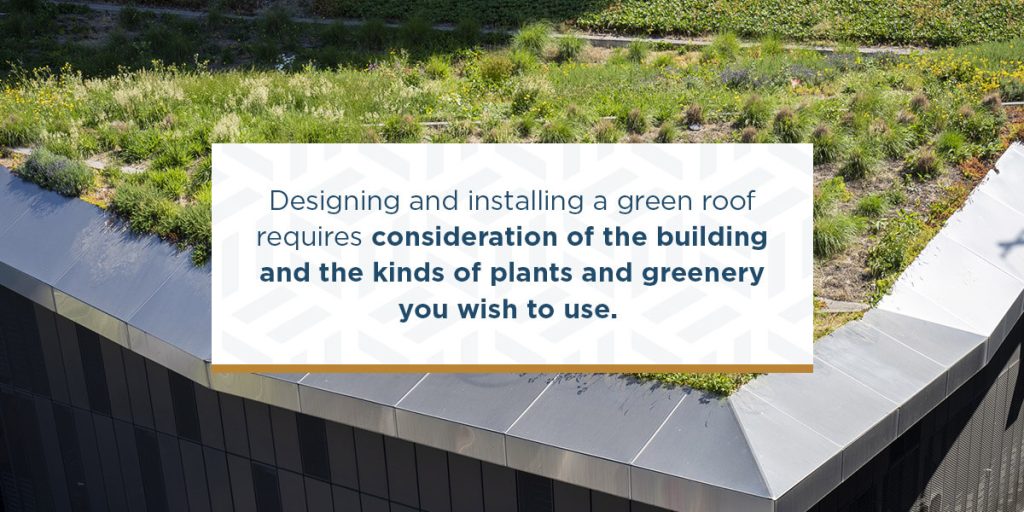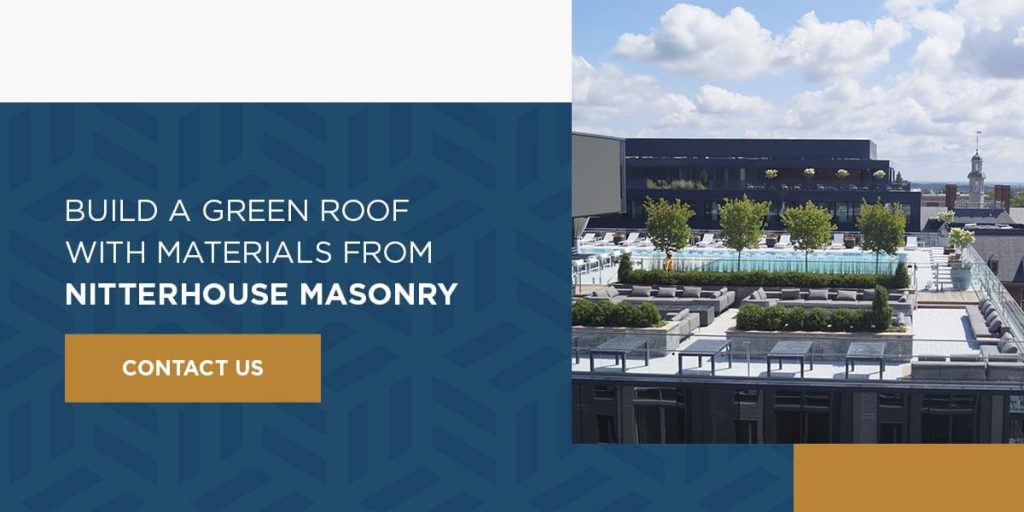
Also known as eco-roofs or vegetative roofs, green roofs offer a beautiful addition to a home or property while improving the environment and raising the property value.
Green roofing is a layer of plants over a waterproof system installed on a flat or slightly sloped roof. The plants can grow as they would in a backyard or garden, or you can separate them in modular planting beds with their own drainage systems.
Understanding the benefits of installing and maintaining a green roof will assist in your decision to build one. Whether you are looking to spruce up a historical home by installing green roofing or trying to upgrade the community by adding plants and greenery, this guide can help.
Different Types of Green Roofs
Green roofs fit into three different categories, each with varying maintenance needs and plant-life options:
- Extensive: Extensive green roofs have shallow growing mediums and modest roof loads. While they offer limited plant diversity, they do have minimal watering needs.
- Intensive: Intensive green roofs use more soil and offer deeper growing mediums that can support diverse plants and even incorporate small trees. Intensive roofs often have a substantial load and need frequent maintenance and watering.
- Semi-intensive: Semi-intensive green roofs feature both kinds of roof types. A semi-intensive roof can have varying roof structures, plants or stormwater requirements.
How to Get Started With Green Roofs

Designing and installing a green roof requires consideration of the building and the kinds of plants and greenery you wish to use. Ask yourself whether the building is suited for a green roof and structurally sound enough to hold one. Ensure that you and your team are ready to work to build an eco-friendly structure.
Design Considerations for Green Roofs
You’ll have many factors to consider when you’re ready to start designing your green roof, including:
- Irrigation: A green roof’s water needs vary by climate and plant choice. Water retention characteristics, such as soil depth and sun or wind exposure, will affect how your plants respond to rain and whether you’ll need to supplement it with irrigation. Be sure you understand the irrigation you’ll need to keep the plants healthy, so they keep reducing your energy demands and maintenance requirements.
- Plant and soil type: Do your research to identify which plants and soils are best for the climate and your preferences. Plants like cacti can conserve water, and plants with crassulacean acid metabolism (CAM) retain more water during photosynthesis. Your choice of soil is vital to support the plants, rainwater and installation.
- Weight: Many roofs can support a few inches of soil without requiring structural changes, but always consult a structural engineer to see if you need additional reinforcements.
- Roof slope: Roofs typically slope to manage water runoff and the degree of the slope often varies by the area’s climate. A low slope is usually best for green roofs, as it helps the soil stay in place and retain water. Steeper slopes may need extra systems to reinforce the greenery.
- Wind management: Most homes aren’t tall enough to require extensive wind management features, but high-rises may need parapets or screens to block wind from damaging the green roof.
- Building preservation: If you’re working on a historic building, consider how you’ll preserve the original facade and foundation of the building. Work with structural engineers and preservationists to approach this kind of project.
Installation of Green Roofs
Before installing a green roof, consult a structural engineer to understand what you’re working with and get approval. Depending on the building’s integrity, you may need to choose between different types of green roofing using pedestal set pavers, which provide waterproofing protection and drainage to the roof. Prepare the roof by ensuring it has an appropriate slope and adding any edging material, like stones or wood frames.
If you’re making your own landscaping area, you can lay down a plastic sheet as a root barrier, foam insulation if necessary and a drainage mat. Then add your soil, plant your greenery and water it.
Another option is to buy your plants in trays specifically for green roofing. The trays have plastic lips to attach to each other and small feet that provide enough elevation for water to drain into the gutters. Simply set your trays in place, starting at the lowest end of the roof and moving upward. Cut your trays to fit and water the plants to help the soil settle.
Maintenance for Green Roofs
Green roofs need continual maintenance to preserve plant life. You’ll need to ensure that you’ve factored each aspect of green roofing into your plan. To maintain a functioning green roof with healthy plants and a proper irrigation system, follow these steps:
- Weeds: Wind and birds can drop seeds onto green roofs, introducing weeds like tree seedlings, dandelion or clover. As the weeds spread, your plants will have to compete with them for water and nutrients. You must weed consistently to ensure your plants are healthy.
- Watering: Many property managers and homeowners choose plants they can leave unwatered for days. However, you may still want to invest in an irrigation system for weeks when water is scarce. Since the water will add extra weight, it’s best to stick to a light sprinkling so as not to compromise the home’s structure.
- Fertilization: The first year after building your green roof is the most crucial time to fertilize your plants. Going forward, test your soil once a year to evaluate its nutrient levels. It might be a good idea to select soil mixed with fertilizer to introduce it to the growing plants installed on the roof.
What Else Can You Do With a Green Roof?
We often think of green roofs as being entirely covered in greenery, but these installations are great for residences, hotels, restaurants and many other buildings. You can use them as a way to incorporate greenery in different spaces:
- Add a pathway winding through the plants for a pleasant rooftop garden.
- Install a green space that blends perfectly with a rooftop restaurant or bar.
- Create outdoor seating areas in crowded urban areas.
The beauty of pavers is that in addition to supporting proper installation for greenery, they also provide a polished, enjoyable space for people to walk, sit, dine or drink. Adding pavers that beautifully match your decor lets you create a luxurious natural extension for your space.
Benefits of Green Roofing
Green roofing has many benefits for the community, homeowner and economy. Understanding how green roofing can improve all three will help in your decision to install a green roof on your home.
Community Benefits
Adding green roofs to your community can:
- Help manage stormwater runoff that can put stress on the sewer systems.
- Reduce the urban heat island effect, which occurs when solar radiation bounces off dark surfaces and increases the air temperature.
- Prevent smog and dust from spreading while catching pollutants in the air.
Using green roofs may also increase the number of jobs in the neighborhood due to the need for constant maintenance and add extra revenue for businesses.
Personal Homeowner Benefits
Green roofs have many benefits for homeowners. The barrier they create can reduce the noise from outside and protect the roof from long-term damage. Since green roofs can reduce building energy use, homeowners can also save money on utility costs.
The property’s value may also increase with the addition of green roofing that makes the house aesthetically pleasing and enhances the efficiency of your household appliances and HVAC system.
Economic Benefits
While a green roof may cost more upfront than a traditional roof, they have many economic benefits to save you money in the long run. Because green roofs help address urban heat islands, they can save energy and lessen HVAC loads. Green roofs can increase property values and make the city marketable in urban areas with little greenery or plants.

Build a Green Roof With Materials From Nitterhouse Masonry
Nitterhouse Masonry Products is a family-owned company with decades of experience in the industrial, commercial and residential building materials industry. We serve customers throughout the Mid-Atlantic region and are committed to offering high-quality products and engineering excellence. Our wide range of products includes concrete blocks, veneer stone, retaining walls, specialty products, brick and site amenities.
Nitterhouse Masonry Products remains the trusted source of materials for construction companies, homeowners and contractors. Contact us to talk to a customer representative or call us today at 717-267-4500.


